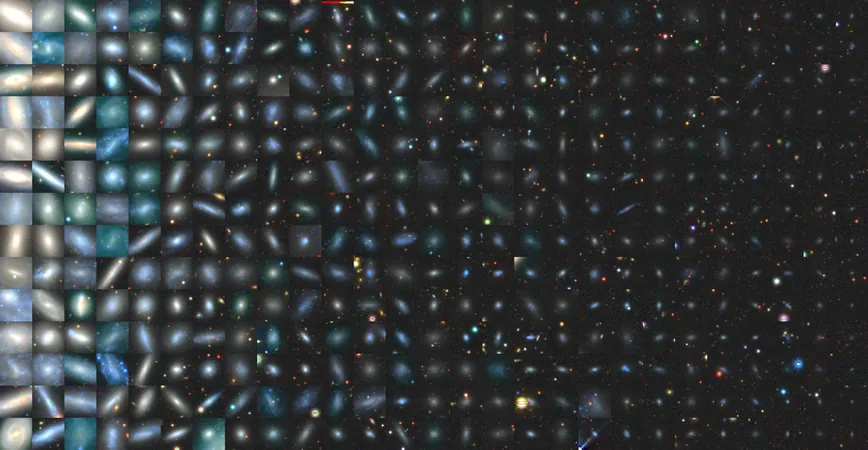
Is the Milky Way Galaxy Special? Groundbreaking Findings from the SAGA Survey!
2024-09-25
Is the Milky Way Galaxy Special? Groundbreaking Findings from the SAGA Survey!
For over a decade, scientists have embarked on an exciting quest to understand whether our home galaxy, the Milky Way, holds a unique position in the cosmos. The Satellites Around Galactic Analogs (SAGA) Survey, initiated in 2013, has been at the forefront of this exploration, meticulously studying galaxy systems akin to our own. Recently, the SAGA team published three groundbreaking research articles on the arXiv preprint server, shedding light on the peculiarities of the Milky Way after analyzing a massive census of 101 satellite systems.
Satellite galaxies, much like the small moons that orbit Earth, are smaller galaxies that orbit larger host galaxies due to the binding gravitational forces at play. The Milky Way is home to a number of these satellite galaxies, with the two most prominent being the Large and Small Magellanic Clouds (LMC and SMC), visible to the naked eye from the Southern Hemisphere. However, many fainter companions remain hidden, only detectable through powerful telescopes.
The Surprising Findings of the SAGA Survey
The main aim of the SAGA Survey is to analyze satellite systems surrounding galaxies that possess similar stellar masses to the Milky Way. Led by Yao-Yuan Mao from the University of Utah, alongside Marla Geha from Yale and Risa Wechsler from Stanford, this study identified a remarkable 378 satellite galaxies across 101 comparable systems.
What stuck out to researchers was the Milky Way's number of confirmed satellites, which is four. Although this seems on par with other Milky Way-like galaxies, it presents a conundrum when considering the presence of the LMC and SMC, as these massive companions seem to be affecting surrounding satellite populations. Mao pointed out that while many systems with a significant satellite like the LMC boast more numerous satellite galaxies, the Milky Way appears to be an anomalous case.
This disparity is intriguing. The article suggests that as the Milky Way is an older, slightly less massive host that has “recently” acquired the LMC and SMC, a diminished number of satellites is to be expected when excluding contributions from these massive companions.
The Critical Role of Environment in Star Formation
The second study from the SAGA team, led by Geha, delves into star formation rates among these satellite galaxies. Evidence suggests that the proximity of a satellite galaxy to its host plays a crucial role in whether it continues to form stars. Those orbiting close to their host are more likely to undergo 'quenching,' where star formation slows or halts. This insight points to the influence of environmental factors on the evolutionary trajectory of these smaller galaxies.
Enhancing Galactic Evolution Models
In the third paper, Yunchong (Richie) Wang, a doctoral student working with Wechsler, utilized SAGA results to refine theoretical models of galaxy formation. His research indicates that quenched satellite galaxies could also exist in isolated conditions, a hypothesis that upcoming astronomical observations, such as the Dark Energy Spectroscopic Instrument Survey, may validate.
A Treasure for the Astronomy Community
In addition to unveiling significant findings, the SAGA Survey team has generously contributed new distance measurements for around 46,000 galaxies, a valuable resource for the astronomical community. Mao emphasized the challenging nature of their work, likening the search for these elusive satellite galaxies to finding needles in a haystack.
As these findings continue to ripple through the scientific community, they not only enhance our understanding of the Milky Way but also critically inform the broader narrative of galaxy evolution. So, is the Milky Way truly special? The debate just became far more fascinating!









 Brasil (PT)
Brasil (PT)
 Canada (EN)
Canada (EN)
 Chile (ES)
Chile (ES)
 España (ES)
España (ES)
 France (FR)
France (FR)
 Hong Kong (EN)
Hong Kong (EN)
 Italia (IT)
Italia (IT)
 日本 (JA)
日本 (JA)
 Magyarország (HU)
Magyarország (HU)
 Norge (NO)
Norge (NO)
 Polska (PL)
Polska (PL)
 Schweiz (DE)
Schweiz (DE)
 Singapore (EN)
Singapore (EN)
 Sverige (SV)
Sverige (SV)
 Suomi (FI)
Suomi (FI)
 Türkiye (TR)
Türkiye (TR)